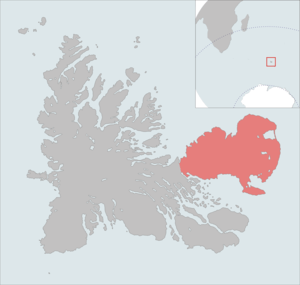Courbet Peninsula

The Courbet Peninsula (Péninsule Courbet) is a large peninsula occupying the northeastern portion of the principal island, Grande Terre, of the subantarctic Kerguelen Archipelago of the southern Indian Ocean. On the south coast of the peninsula is the French research station of Port-aux-Français, the only permanent settlement in the archipelago. Molloy, 10 km to the west of Port-aux-Francais along the north shore of the Gulf of Morbihan, is the site of a former observatory, established on 7 September 1874, by an American expedition led by G. P. Ryan, to observe the 1874 Transit of Venus.
Environment
Geography
The Courbet Peninsula is relatively flat, composed mainly of alluvial deposits of glacial origin, with altitudes in the eastern part not exceeding 200 m. The western part is hillier and reaches 500 m. It contains many lakes with boggy margins, though much of the inland area is dry and largely unvegetated.[1] Some 55 km long, the peninsula is about 10 km wide at its western base and widens to more than 20 km across further east. The southern coast of the peninsula forms the northern limit of the Gulf of Morbihan. At its south-eastern end is Norwegian Bay. The easternmost point of the peninsula, and of Grande Terre, is Cape Ratmanoff, north of which is coastal Lake Marly. Further north still is Cape Digby, marking the north-eastern end of the peninsula. The northernmost point of the peninsula is Cape Cotter.
Important Bird Area
Much of the peninsula has been identified by BirdLife International as a 600 km2 Important Bird Area (IBA) because of its value as a breeding site, especially for seabirds, with at least 22 species nesting there. Three large colonies of King Penguins are found on the north-western coast, with a combined total of 172,400 pairs. There are several Macaroni Penguin colonies along the northern coast. The inland parts of the peninsula are important for holding the largest population of Eaton's Pintails. There are some 300 pairs of Wandering Albatrosses and up to 800 pairs of Northern Giant Petrels. There are also large numbers of breeding Gentoo Penguins, Kerguelen Shags, Black-faced Sheathbills, Brown Skuas, Kerguelen and Antarctic Terns, and Kelp Gulls.[1]
The IBA holds the largest breeding population of Southern Elephant Seals in the archipelago, with 43,782 females recorded in 1997. The peninsula also holds a breeding colony of Antarctic Fur Seals.[1]
References
- ↑ 1.0 1.1 1.2 BirdLife International. (2012). Important Bird Areas factsheet: Péninsule Courbet. Downloaded from http://www.birdlife.org on 2012-01-11.
| ||||||||||||||
Coordinates: 49°15′S 70°12′E / 49.250°S 70.200°E